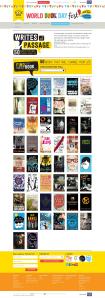At last weekend’s Romance Festival 2014, I participated in a Q & A session with a book cover designer. Mr Mark Ecob has designed covers from children’s books to coffee table books. You could view his portfolio at mecob.org
I would like to share with you some parts of the Q & A session. Texts written in bold are questions/thoughts from the participants.
Do you read the books which you design covers for?
As a rule, absolutely – I think you owe it to the author. there are times when rewind it is a bad idea, you can get too close to it, but I would say the former is better. Briefs from my clients can fall short of what you need as a designer, I’ve never found the perfect one, a lot of them think its just ok to paste cover blurb into an email which is just lazy.
Are there stages when creating a book cover?
Sure, it starts with reading it and being briefed by a client, you submit rough covers to them which are then tweaked until everyone has a cover they’re happy with, and then you prepare it for print or its online outing. That’s a huge simplification, but generally covers it. It can also be a very complicated process, or a very simple one. Overall I think its best to let designers do their thing, that’s what their expertise is. The trick is choosing the right one for your book.
How long does that take? Also how long does it take you to create a cover?
Getting the right cover can take a day or a year! I once worked on one that took three years and still wasn’t right in my opinion (long story), but generally a month is a good rule of thumb. It should not be rushed.
How do you know when a cover is right? What cover(s) are you most proud of?
That’s a difficult one, I’m proud of them all in different ways. Recently, my work on Iain Banks has been the most rewarding.
How do you decide on a cover whether title, author name or image is the most important factor?
It’s a mix of factors, it depends on an author’s track record, whether they’re new or established, but I would say overall that if an author is a good name with rising popularity, then we focus on that. Sometimes a quote can be the most important point of focus on a cover.

The book cover of Jojo Moyes’s The One Plus One
Are there current cover design trends that are phasing out or overdone?
It’s like flares coming back in fashion, each trend has a cycle in my experience and can come back any time. Good design can be about nodding to what’s gone before or blazing a trail – depends on the situation. In women’s fiction, there are still amazing examples of illustration, I was commissioning women’s fiction illustration form artists still working in this area now, when I started in 2001. I would say that you need to be aware of the commotion but not ape it, if you look at the latest Jojo Moyes from Penguin, it straddles all of the trends for me – strong central type motif where you can still read the author at scale, a touch of illustration but kept simple, feminine but not teenage/pink colour palette. Dare I say it, I would read that one.

The book cover of Stephenie Meyer’s Twilight
I notice more and more books in erotic romance genre tend to be show provocative poses. I am from a conservative country so reading those in paperback would make me self-conscious. I’m getting tired of seeing those. I’d rather like a cover that is figurative e.g. Stephanie Meyer‘s Twilight
A publisher will go for the majority in their market, so if the provocative images sell to more people than not, that’s what they’ll go for. You raise a very interesting question though. I think its impossible to create one global cover that would appeal to every market, but publishers have an obligation to listen to readers.
The take-away point from the session: book cover design is a key element of book production. There are many people involved in the process – designer, author and publisher – and they should all work together to get a cover everyone’s happy with.
I end this post with a lovely quote from Mark,
“Good design will help you buy a book, bad design won’t. It’s just like any packaging you’re sold as a consumer. In my opinion, I think you should judge a book by its cover – if its designed right, you should be proud to be seen reading it.”
If you would like to read the full Q & A session, look for this post on the Romance Festival 2014 Facebook page
.




